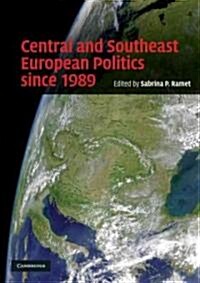
Central and southeast European politics since 1989
- 발행사항
- Cambridge, UK ; New York : Cambridge University Press, 2010
- 형태사항
- xxxiii, 563 p.: ill., maps ; 24cm
- ISBN
- 9780521716161
- 청구기호
- 340.92 R172c
- 서지주기
- Includes bibliographical references and index
소장정보
| 위치 | 등록번호 | 청구기호 / 출력 | 상태 | 반납예정일 |
|---|---|---|---|---|
이용 가능 (1) | ||||
| 1자료실 | 00012620 | 대출가능 | - | |
- 등록번호
- 00012620
- 상태/반납예정일
- 대출가능
- -
- 위치/청구기호(출력)
- 1자료실
책 소개
A complete introduction to Central and Eastern European politics, providing both a thematic and a comparative country-by-country analysis.
목차
Preface; Part I. Introduction: 1. Introduction Sabrina P. Ramet; 2. Post-socialist models of rule in Central and Southeastern Europe Sabrina P. Ramet and F. Peter Wagner; Part II. Issues: 3. The emergence of the nation-state in East-Central Europe and the Balkans in historical perspective Reneo Lukic; 4. Central and East European party systems since 1989 Elisabeth Bakke; 5. Economic reforms and the illusion of transition Karl Kaser; 6. The war of Yugoslav succession Marko Attila Hoare; Part III. Central Europe: 7. Poland since 1989: muddling through, wall to wall Konstanty Gebert; 8. Building democratic values in the Czech Republic since 1989 Carol Skalnik Leff; 9. Slovakia since 1989 Erika Harris; 10. Hungary since 1989 Andras Bozoki and Eszter Simon; Part IV. Yugoslav Successor States: 11. Slovenia since 1989 Danica Fink-Hafner; 12. Politics in Croatia since 1990 Sabrina P. Ramet; 13. Serbia and Montenegro since 1989 Sabrina P. Ramet; 14. Bosnia and Herzegovina since 1990 Florian Bieber; 15. Macedonia since 1989 Zachary T. Irwin; 16. Kosova: resisting expulsion and striving for independence Frances Trix; Part V. Southeastern Europe: 17. Romania: in the shadow of the past Lavinia Stan; 18. Bulgaria since 1989 Maria Spirova; 19. Albania since 1989: the Hoxhaist legacy Bernd Jurgen Fischer; Part VI. Former Soviet Republics: 20. The Baltic states Hermann Smith-Sivertsen; 21. Moldova since 1989 Steven D. Roper; Part VII. Present and Future Challenges: 22. Regional security and regional relations Rick Fawn; 23. The EU and democratization in Central and Southeastern Europe since 1989 Ulrich Sedelmeier; 24. Facing the twenty-first century: lessons, questions, and tendencies (a conclusion) Aurel Braun.

